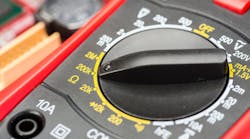Do you know what the resolution is on your DMM? It might be important, especially for preventive maintenance (PM) purposes. To help illustrate this, let's look at a different type of instrument — one you may have in your home.
Let’s say you have two digital bathroom scales. One of them has a half-pound resolution; that is, it will read out in half-pound increments. If you just need a general idea of how much you weighed last month compared with how much you weigh this month, this scale is probably fine.
The other one reads out in 1/10th-pound increments. If you see you’re gaining a tenth of a pound every day and this goes on for several days, you’ve got evidence that something isn’t right. Maybe you’re overeating or maybe you’ve got a blockage. But you can clearly see a trend in the wrong direction. With the other scale, you wouldn’t notice a trend over this same time frame.
With the half-pound increment scale, you’d notice after five days you’re up half a pound. But were you at 0.4 pounds above the next lowest weight, or right on it five days ago? This is a big difference. To see a trend with the lower-resolution scale, you’d have to wait at least 15 days before you had information you could reasonably identify as a trend.
A similar dynamic is at play when selecting a DMM, though the goal, of course, is different. The better the resolution, the better your ability to spot trends more quickly. When taking measurements during a PM procedure, select the highest resolution on the DMM and record the full value. This will help convert that portion of the PM work to predictive maintenance (PdM).
Of course, this means everyone taking that measurement should have a meter with that level of high resolution. Typically, resolution is measured as the number of counts. For example, you may see 40,000 counts in the specs (that’s a number from the specs of a couple of meters looked at for this article; two other meters had 1/10th as many). Factor in resolution when choosing a DMM. Higher isn’t always better, but for your applications it could be.




